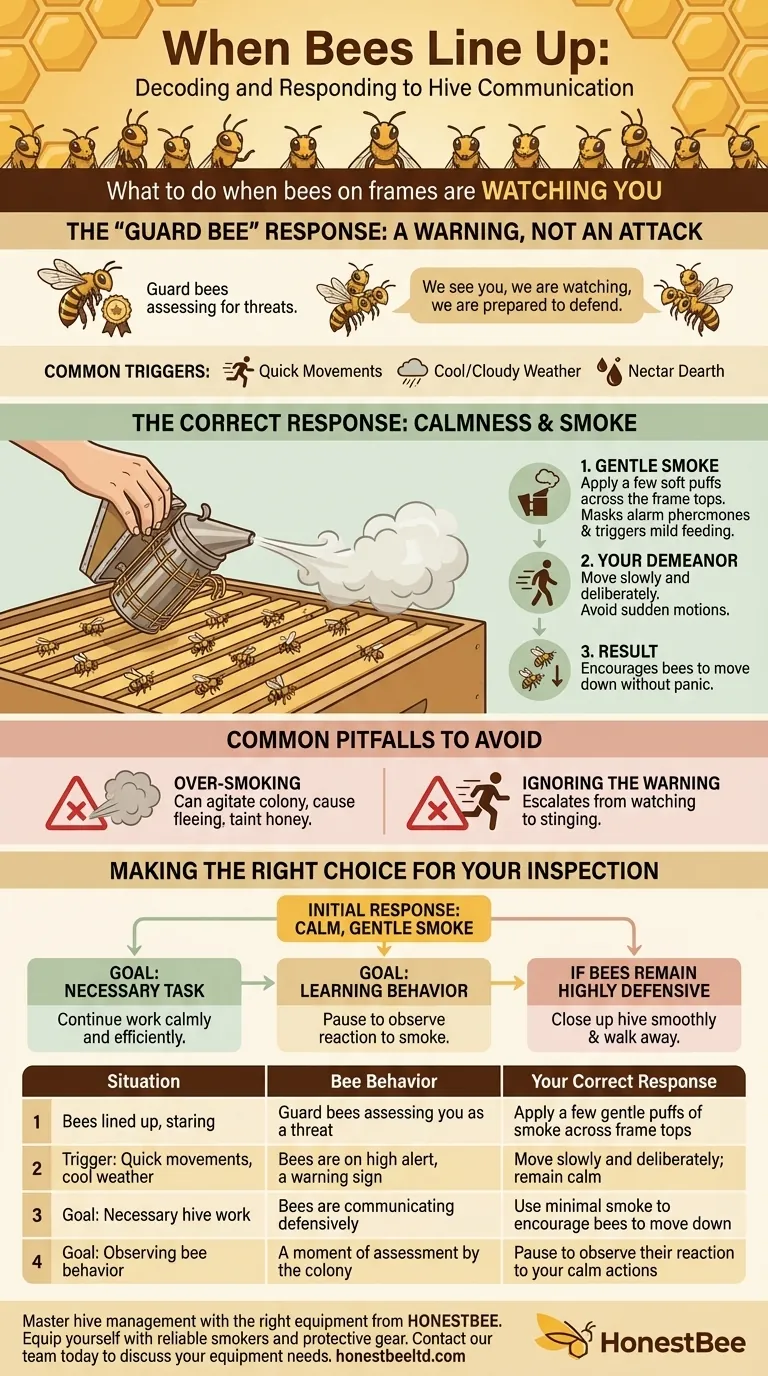When you see a line of bees staring up at you from between the frames, you are witnessing a clear communication signal from the colony. This behavior indicates that the bees are aware of your presence and are assessing you as a potential threat. Your immediate and correct response is to apply a few gentle puffs of smoke across the tops of the frames to encourage them to move back down.
This lineup of "guard bees" is a warning sign, not an immediate attack. It's the hive's way of telling you to be calm, slow down, and proceed with respect. How you respond in this moment determines whether the inspection continues peacefully or escalates into a defensive event.
Decoding the Behavior: Why Bees Line Up
Seeing bees align and watch you can be unnerving, but it is a predictable part of bee behavior. Understanding what it means is the first step toward managing it effectively.
The "Guard Bee" Response
The bees you see are typically guard bees or middle-aged bees whose roles include colony defense. They have moved up from their tasks to investigate the major disturbance of their hive being opened.
A Warning, Not an Attack
This posture is a clear signal that they are on alert. They are communicating, "We see you, we are watching you, and we are prepared to defend our home." It is a moment of assessment, not overt aggression.
Common Triggers for Alertness
This behavior can be prompted by several factors, including the speed at which you open the hive, jarring or sudden movements, or even the weather. Hives tend to be more defensive on cool, cloudy days or during a nectar dearth.
The Correct Response: Calmness and Smoke
Your actions in this critical moment will set the tone for the rest of the inspection. The goal is to de-escalate the situation, not force your way through it.
The Purpose of Gentle Smoke
Smoke is your primary tool for communication. It works by masking the alarm pheromones that guard bees release to signal danger to the rest of the colony. It also triggers a mild feeding response, distracting them from their defensive duties.
Applying Smoke Correctly
The key is to use a few soft puffs, not a large cloud. Aim the smoke gently across the top of the frames where the bees are lined up. This encourages them to move down and away without causing panic or excessive disruption.
The Importance of Your Demeanor
Your own body language is critical. As the bees are assessing you, you must demonstrate that you are not a threat. Move slowly and deliberately. Avoid swatting at bees or making sudden, jerky motions.
Common Pitfalls to Avoid
Responding incorrectly can quickly escalate a simple warning into a defensive hive that is difficult to work with. Understanding what not to do is just as important as knowing the right steps.
The Risk of Over-Smoking
Using too much smoke is a common beginner mistake. It can overly agitate the colony, cause bees to flee the hive, and potentially taint the flavor of nearby honey. Use the minimum amount necessary to achieve the desired result.
Ignoring the Warning Signal
If you ignore the line of bees and continue your inspection with fast or clumsy movements, you are signaling that you are a threat. The bees will likely escalate their response from watching to head-butting, buzzing dives, and eventually, stinging.
Making the Right Choice for Your Inspection
How you proceed depends on your goal for opening the hive and the bees' reaction to your initial, calm response.
- If your primary focus is a necessary task: Apply gentle smoke to move the bees along and continue your work calmly and efficiently.
- If your primary focus is learning bee behavior: Pause for a moment to observe. See how they react to the smoke and how their posture changes. This is a valuable learning opportunity.
- If the bees remain highly defensive after smoking: Close up the hive smoothly and walk away. Your goal is a low-stress inspection, and forcing your way through an agitated colony benefits no one.
Reading your bees' signals is the key to becoming a confident and effective beekeeper.
Summary Table:
| Situation | Bee Behavior | Your Correct Response |
|---|---|---|
| Bees lined up, staring | Guard bees assessing you as a threat | Apply a few gentle puffs of smoke across frame tops |
| Trigger: Quick movements, cool weather | Bees are on high alert, a warning sign | Move slowly and deliberately; remain calm |
| Goal: Necessary hive work | Bees are communicating defensively | Use minimal smoke to encourage bees to move down |
| Goal: Observing bee behavior | A moment of assessment by the colony | Pause to observe their reaction to your calm actions |
Master hive management with the right equipment from HONESTBEE.
Equip yourself with reliable smokers and protective gear designed for commercial apiaries and distributors. Proper tools are essential for reading bee behavior and conducting low-stress inspections. Let HONESTBEE's wholesale-focused operations support your beekeeping success.
Contact our team today to discuss your equipment needs and enhance your apiary's efficiency.
Visual Guide

Related Products
- Galvanized Beekeeping Smoker for Honey Bee and Apiculture
- Premium Traditional Copper Bee Smoker with Bellows
- Stainless Steel Honey Bee Smoker Hive and Honeycomb Smoker for Beekeeping
- Electric Bee Smoker European Style Bee Hive Smoker for Beekeeping
- Economy Galvanized Beekeeping Honey Bee Smoker for Wholesale
People Also Ask
- What factors should be considered when purchasing a beekeeping suit or jacket? Your Guide to Safety and Comfort
- What is the purpose of a beekeeping suit? Achieve Safe & Confident Hive Management
- Why is ventilated clothing recommended for beekeeping in summer? Stay Cool and Protected for Better Hive Inspections
- What are the pros of wearing a bee jacket? Gain Speed and Comfort for Your Hive Inspections
- Why is it important to regularly launder clothing and gloves used in beekeeping? Ensure Hive Health & Beekeeper Safety



















